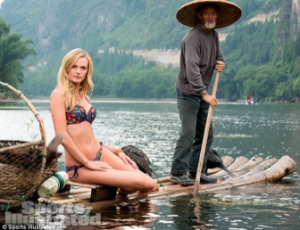
Courtney Gallagher
ASNS 2076: Fashion and Gender in China
Prof Shu-chin Tsui
In this Sports Illustrated advertisement, a stark contrast is drawn between the Western female figure and the Chinese male figure, for the purpose of selling the Western lifestyle (sound statement). The exploitation of these two figures is meant to target the desires of Western males, the dominant reader base of Sports Illustrated. The “swimsuit spread” [started in 1970] and is featured on an annual basis. The original intent of the spread was to fill space in the magazine during a time of less sporting activity, as well as heighten sales during a time of slower sale [less sports events], by showing scantily clad women in exotic locations. Since the first edition, this issue of the magazine has become the most popular.
Western Woman v. Chinese Male: Both the gender and ethnic background of the figures featured in this advertisement are being exploited to sell the Western lifestyle. Sports Illustrated exhibits the Western female in her “natural state”—as a temptress, in the wild and ripe for exploitation. The Western woman appears as if she is an exotic place [China], sitting effortlessly — seemingly waiting for someone [waiting to be sold or consumed by the male viewer.] On the other hand, the Chinese male appears as if he is going about his normal work duties. The Chinese male is being used as an ethnic prop used to highlight the exotic location presented. In this way, his life and culture is being exploited and commercialized as a means of selling the Western “way of life.” As a representation of the “ideal, Western lifestyle,” this advertisement highlights Western male fetishism with the foreign, exotic, and authentic Chinese [shown through the Chinese male], as well as their obsession with sexuality and eroticism [shown through the Western woman.] In order to achieve this image, Sports Illustrated exploits both figures.
the significance of the contrast and difference
Naked Body v. Working Body: The naked body of the female is also contrasted with the working body of the male in this advertisement—both as a form of exploitation. The white woman lays on the raft, revealing her body in submission to the male viewer. Her gaze is straight on—suggesting an invitation to act upon desires and sexual fantasies of the male reader. On the other hand, the fisherman is standing and working, fully clothed in his work attire. His gaze is downward in order to avoid the gaze of the viewer, where he serves as a prop to emphasize the “exotic” location. In this way, he is used as a way to further eroticize the already sexualized, naked body where the male viewer sees himself acting upon desire in an exotic location.
stay with the statement of “western life style?”
Location: The hyper-sexualized, submissive Western woman and the traditional Chinese fisherman are both contrasted with the landscape—all of which is commoditized for the reader’s pleasure. The unnatural and demeaning way in which both the male and female is depicted in this picture is contrasted with the natural beauty of the landscape. However, the landscape is blurry allowing the reader to focus more directly to the exploitation of the foreground. The landscape is just another prop to further the erotic and exotic nature of the exploitative picture, which serves to fulfill Western males desire of eroticism and exoticism. The natural and pure beauty of the background is corrupted through its objectification and commodification.
the significance or the selling point of Chinese landscape?
Both the Western, sexualized woman and Chinese male are dehumanized and objectified in order to arouse the desires of Western males. Through these pages, the Western males can live out their sexual fantasies, while “Orientalizing” Chinese culture. Offensively, it objectifies the Western woman by selling her sexuality, selling her body. The magazine is also selling a skewed, Orientalist vision of Chinese culture—where the inferiority of the impoverished Chinese male serves simply as a prop in the issuers manufactured sexual fantasy. The exploitation of the Western, sexualized woman and Chinese, Orientalized male highlight that the age-old issue of race, culture, and gender is still very much alive in Western society.
nice post
